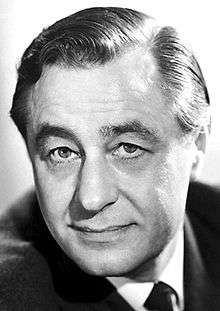George Porter
| The Lord Porter of Luddenham | |
|---|---|
 | |
| Born |
George Hornidge Porter 6 December 1920 Stainforth |
| Died | 31 August 2002 (aged 81) |
| Nationality | British |
| Fields | Chemistry |
| Institutions | |
| Alma mater |
|
| Thesis | The study of free radicals produced by photochemical means (1949) |
| Doctoral advisor | Ronald Norrish |
| Known for | Flash Photolysis |
| Notable awards |
|
George Hornidge Porter, Baron Porter of Luddenham OM PRS[1] (6 December 1920 – 31 August 2002) was a British chemist.[3] He was awarded the Nobel Prize in Chemistry in 1967.
Education and early life
Porter was born in Stainforth, near Thorne, South Yorkshire. He was educated at Thorne Grammar School,[4] then won a scholarship to the University of Leeds and gained his first degree in chemistry. He was awarded a PhD from the University of Cambridge in 1949 for research investigating free radicals produced by photochemical means.[5]
Career and research
Porter served in the Royal Naval Volunteer Reserve during the Second World War. Porter then went on to do research at the University of Cambridge supervised by Ronald George Wreyford Norrish where he began the work that ultimately led to them becoming Nobel Laureates.
His original research in developing the technique of flash photolysis to obtain information on short-lived molecular species provided the first evidence of free radicals. His later research utilised the technique to study the minutiae of the light-dependent reactions of photosynthesis, with particular regard to possible applications to a hydrogen economy, of which he was a strong advocate.
He was Assistant Director of the British Rayon Research Association from 1953–4, where he studied the phototendering of dyed cellulose fabrics in sunlight.[6]
Porter became a professor in the Chemistry department at the University of Sheffield in 1954-55. It was here he started his work on Flash Photolysis with equipment designed and made in the departmental workshop. During this tenure he also took part in a television programme describing his work. This was in the "Eye on Research" series. Porter became Fullerian Professor of Chemistry and Director of the Royal Institution in 1966. During his directorship of the Royal Institution, Porter was instrumental in the setting up of Applied Photophysics, a company created to supply instrumentation based on his group's work. He was awarded the Nobel Prize in Chemistry in 1967 along with Manfred Eigen and Ronald George Wreyford Norrish.[7] In the same year he became a Visiting Professor at University College London.[7]
Porter was a major contributor to the public understanding of science. He became president of the British Association in 1985 and was the founding Chair of the Committee on the Public Understanding of Science (COPUS). He gave the Romanes Lecture, entitled "Science and the human purpose", at the University of Oxford in 1978; and in 1988 he gave the Dimbleby Lecture, "Knowledge itself is power". From 1990 to 1993 he gave the Gresham lectures in astronomy.
Awards and honours
Porter was elected a Fellow of the Royal Society (FRS) in 1960[1] and served as President of the Royal Society from 1985–1990. He was also awarded the Davy Medal in 1971, the Rumford Medal in 1978, the Ellison-Cliffe Medal in 1991 and the Copley Medal in 1992.
Porter also received an Honorary Doctorate from Heriot-Watt University in 1971.[8]
He was knighted in 1972, appointed to the Order of Merit in 1989,[9] and was made a life peer as Baron Porter of Luddenham, of Luddenham in the County of Kent, in 1990. In 1995, he was awarded an Honorary Degree (Doctor of Laws) from the University of Bath.[10]
In 1976 he gave the Royal Institution Christmas Lecture on The Natural History of a Sunbeam.[11]
Porter served as Chancellor of the University of Leicester between 1984 and 1995. In 2001, the university's chemistry building was named the George Porter Building in his honour.
References
- 1 2 3 Fleming, G. R.; Phillips, D. (2004). "George Porter KT OM, Lord Porter of Luddenham. 6 December 1920 - 31 August 2002: Elected F.R.S. 1960". Biographical Memoirs of Fellows of the Royal Society. 50 (0): 257–283. doi:10.1098/rsbm.2004.0017. ISSN 0080-4606.
- ↑ Weisskopf, V. F.; Eyring, H.; Eyring, E. M. (1967). "1. Physics". Science. 158 (3802): 745–748. doi:10.1126/science.158.3802.745. PMID 4860395.
- ↑ Phillips, David (2002). "Obituary: George Porter (1920–2002)". Nature. 419 (6907): 578. doi:10.1038/419578a. PMID 12374966.
- ↑ "The Oxford Dictionary of National Biography". 2004. doi:10.1093/ref:odnb/77183.
- ↑ Porter, George (1949). The study of free radicals produced by photochemical means (PhD thesis). University of Cambridge.
- ↑ David Phillips The Biography of George Porter. icpress.co.uk
- 1 2 "George Porter – Biography". Nobel Media. Retrieved 30 April 2011.
- ↑ [email protected]. "Heriot-Watt University Edinburgh: Honorary Graduates". www1.hw.ac.uk. Retrieved 2016-04-07.
- ↑ "BBC NEWS Science/Nature Obituary: Lord Porter". BBC Online. BBC News. 2 September 2002. Retrieved 7 March 2016.
- ↑ "Honorary Graduates 1989 to present". bath.ac.uk. University of Bath. Retrieved 18 February 2012.
- ↑ "George Porter – Famous Experiments", Ri Channel video, 6 December 1985
External links
| Wikiquote has quotations related to: George Porter |
- Profile – Royal Institution of Great Britain
- The Life and Scientific Legacy of George Porter, World Scientific Publishing, 2006
- Obituary in The Guardian, 3 September 2002
- Biographical Database of the British Chemical Community, 1880–1970
- "The Relevance of Science". George Porter. JASA (Journal of the American Scientific Affiliation) Vol. 28. March 1976. pp. 2–3.(Includes editorial responses from astronomer Owen Gingerich and theologian Bernard Ramm amongst others.)
| Cultural offices | ||
|---|---|---|
| Preceded by William Lawrence Bragg |
Director of the Royal Institution 1966–1986 |
Succeeded by John Meurig Thomas |
| Academic offices | ||
| Preceded by Sir Alan Hodgkin |
Chancellor of the University of Leicester 1984–1995 |
Succeeded by Sir Michael Atiyah |
